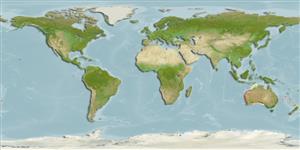Actinopterygii (ray-finned fishes) >
Anguilliformes (Eels and morays) >
Muraenidae (Moray eels) > Muraeninae
Etymology: Gymnothorax: Greek, gymnos = naked + Greek, thorax, -akos = breast (Ref. 45335); cephalospilus: From the Greek kephale meaning head and spilos meaning spot. Noun in apposition.. More on author: McCosker.
Environment / Climate / Range
Ecology
Marine; demersal; depth range 125 - 134 m (Ref. 41234). Subtropical, preferred ?
Indo-West Pacific: eastern and western Australia.
Size / Weight / Age
Maturity: Lm ? range ? - ? cm
Max length : 20.2 cm TL male/unsexed; (Ref. 41234)
Short description
Morphology | Morphometrics
Vertebrae: 142 - 146. A small, slender, dark brown moray with contrasting eye-sized white spots on head; spots fewer toward anus, very few or lacking on tail; anus at midbody, preanal length 2.0 in TL; depth at gill opening 18-22 in TL; head 8.2-9.3 in TL; teeth stout, no long canines; MVF 6-64-145.
Life cycle and mating behavior
Maturity | Reproduction | Spawning | Eggs | Fecundity | Larvae
Böhlke, E.B. and J.E. McCosker, 2001. The moray eels of Australia and New Zealand, with description of two new species (Anguilliformes: Muraenidae). Rec. Aust. Mus. 53(1):71-102. (Ref. 41234)
IUCN Red List Status (Ref. 115185)
CITES (Ref. 94142)
Not Evaluated
Threat to humans
Harmless
Human uses
More information
Common namesSynonymsMetabolismPredatorsEcotoxicologyReproductionMaturitySpawningFecundityEggsEgg development
Age/SizeGrowthLength-weightLength-lengthLength-frequenciesMorphometricsMorphologyLarvaeLarval dynamicsRecruitmentAbundance
ReferencesAquacultureAquaculture profileStrainsGeneticsAllele frequenciesHeritabilityDiseasesProcessingMass conversion
Tools
Special reports
Download XML
Internet sources
Estimates of some properties based on models
Phylogenetic diversity index (Ref.
82805): PD
50 = 0.5000 [Uniqueness, from 0.5 = low to 2.0 = high].
Bayesian length-weight: a=0.00095 (0.00047 - 0.00196), b=3.10 (2.93 - 3.27), in cm Total Length, based on LWR estimates for this Genus-body shape (Ref.
93245).
Trophic Level (Ref.
69278): 3.7 ±0.6 se; Based on size and trophs of closest relatives
Resilience (Ref.
69278): High, minimum population doubling time less than 15 months (Preliminary K or Fecundity.).
Vulnerability (Ref.
59153): Low vulnerability (23 of 100) .
